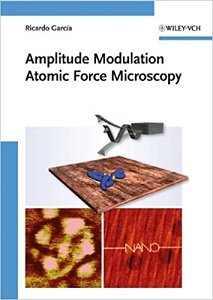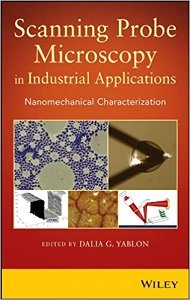Where do we get our knowledge from?
Books don’t often make the list within a lot of science. However when we asked the AFM Community about the resources they turn to when working with AFM a number of you DID come back with some key suggested texts.
Whilst a number of the books have been around for a while and are recognised as ‘classic’ texts, the increased use of AFM within different disciplines and for different purposes is being mirrored in the variety of books being published.
Building on your feedback, and whilst this list is far from exhaustive, we’ve curated a selection of 12 Brilliant Books on Atomic Force Microscopy that you might find of interest and useful in your work:
1) Peter Eaton and Paul West’s Atomic Force Microscopy Oxford University Press (2010) - This classic text was the starting point from which the website afmhelp.com emerged, run and regularly updated by author Peter Eaton, with the explicit objective to contain all the AFM related material they couldn’t fit into the book! There’s a lot of love for the website from the AFM Community and wholesale agreement that the book behind it is a must-have too.
2) Ricardo Garcia’s Amplitude Modulation Atomic Force Microscopy Wiley (2012) - If it’s an in-depth overview of tapping mode you need, this is the book for you. It is currently out of print, however it is worth checking with your institution library as they may have a copy.
3) Greg Haugstad’s Atomic Force Microscopy: Understanding Basic Modes and Advanced Applications Wiley (2012) - Covering the basic surface properties and distance-dependent intersurface forces you need to understand to obtain even simple data from an atomic force microscope (AFM) and includes information on imaging, materials property characterization, in-liquid interfacial analysis, tribology, and electromagnetic interactions.
4) Dalia Yablon’s Scanning Probe Microscopy in Industrial Applications: Nanomechanical Characterization Wiley (2013) - The first half provides a general overview of nanomechanical characterization methods, offering a complete practical tutorial for readers who are new to the topic. Several chapters include worked examples of useful calculations such as using Hertz mechanics with and without adhesion to model a contact, step-by-step instructions for simulations to guide cantilever selection for an experiment, and data analysis procedures for dynamic contact experiments.
5) Malgorzata Lekka’s Cellular Analysis by Atomic Force Microscopy, Jenny Stanford Publishing (2017) - Despite substantial evidence showing the feasibility of AFM to identify cells with altered elastic and adhesive properties, the use of this technique as a complementary diagnostic method remains controversial. This book is a practical textbook that teaches how to assess the mechanical characteristics of living, individual cells by AFM.
6) Paul Verkade (Editor), Lucy Collinson (Editor)’s Correlative Imaging: Focusing on the Future Wiley (2019) - Section 6 of this 2019 RMS Series publication is written by Georg Fantner and Frank Lafont and focuses on Correlative Microscopy using Scanning Probe Microscopes, including AFM. The section documents what’s already been tried and future developments in this area.
7) Nuno C. Santos and Filomena A. Carvalho (Editors)’s Atomic Force Microscopy: Methods and Protocols Springer (2019) - This practical book is filled with cutting-edge lab techniques and step-by-step details essential for reproducible results and is therefore brilliant in its own right. However we would be remiss if we didn’t also point out the second chapter in the Imaging section ‘Quantitative Analysis of Structure and Dynamics in AFM Images of Lipid Membranes’ was co-authored and based on data gathered by our very own Jamie Goodchild! Cue loud cheering from NuNano HQ. Great work Jamie.
8) Bert Voigtlander’s Atomic Force Microscopy Springer Nature Switzerland AG (2020) - Part of the NanoScience and Technology series. This enhanced second edition to "Scanning Probe Microscopy" (Springer, 2015) explains the operating principles of atomic force microscopy with the aim of enabling the reader to operate a scanning probe microscope successfully and understand the data obtained with the microscope.
9) Jess Wade’s Nano: The Spectacular Science of the Very (Very) Small Walker Books (2021) – Perfect of course for inspiring the next generation! Beautifully illustrated by Melissa Castrillon and engagingly narrated by Jess Wade this book is a great gateway drug into STEM for the little people in your life (and the big ones for that matter!).
10) Jian Zhong, Claire Gaiani, Yang Hongshun’s Fundamentals and Application of Atomic Force Microscopy for Food Research Academic Press Inc, (2022) – This is the first book, apparently, to explain how to get reliable AFM data from different food substances, as well as highlighting current progress of AFM Food applications. This one had to make our list as the career of our illustrious co-founder Dr Mervyn Miles veered for a while into AFM in food research – though a few years prior to this book being written of course!
11) Cai Shen (Editor)’s Atomic Force Microscopy for Energy Research, CRC Press (2022) - In this book, the basic principles of functional AFM techniques and their applications in energy materials—such as lithium-ion batteries, solar cells, and other energy-related materials—are addressed.
12) Yu Kyoung Ryu and Javier Martinez Rodrigo’s Scanning Probe Lithography: Fundamentals, Materials, and Applications, CRC Press (2023) – Hot off the press, this book is apparently the most complete available on scanning probe lithography (SPL). Whilst SPL is something of a derivative technique (based on the ability of AFM to create variable surface patterns) the eagle eyed amongst you may have noticed lead author Yu Kyoung Ryu was interviewed as part of our Women in AFM series a while back and we couldn’t resist taking this opportunity to cheerlead the publication of her latest project.
As mentioned earlier, this list is certainly not exhaustive. In fact there are multiple other titles on different AFM specialties that you can find including Conductive AFM, AFM in liquid, High Speed AFM, and many more!
Are there other books on the subject of AFM you’d recommend to the AFM Community? If so, we’d love to hear from you – contact us community@nunano.com
If you enjoyed this blog post you might also like The AFM Community Resources ‘One-Stop Shop’












